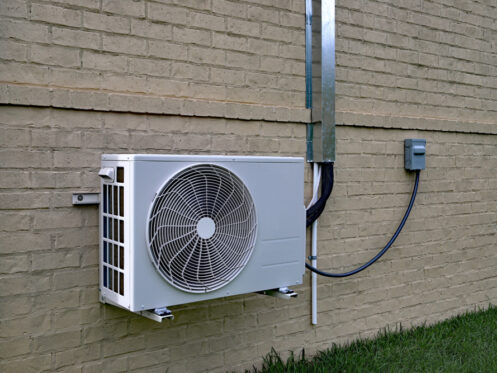Looking for a flexible and affordable home heating and cooling solution that doesn’t require installing HVAC ducts throughout your space? A ductless mini split system installed by the skilled team at High 5 might be the solution you’ve been searching for.
What is a mini split, and is it right for you? Learn everything you need to know about ductless mini split air conditioners, including how they work, the differences between them and standard AC units, the benefits of ductless systems, and when to use them over other options.
How Do Ductless Mini Split Systems Work?
A ductless mini split system is a standalone unit that uses individual blowers (mounted on walls or ceilings) in order to control the temperature of a particular room or area. It’s common to install multiple mini split systems throughout a home, each connected by a small refrigerant line to a single outdoor condenser unit.
When you run your ductless air conditioner, the indoor blower uses refrigerant to cool the air, which then streams into the space. This same process can also work in reverse to heat the space, making it a flexible option for year-round use.
Central AC vs. Ductless Mini Splits: What’s the Difference?
The mechanism used to cool the air is essentially the same between central AC and ductless mini splits. However, with a central AC, the air is circulated throughout the house from a single air conditioner via ductwork. With a mini split, no ductwork is required, and the unit simply blows cool or warm air into the surrounding area.
The other main difference is in functionality. Traditional air conditioners typically lack heating capabilities, whereas most ductless systems are capable of both heating and cooling.
Pros of Ductless Mini Split Systems
As with most home HVAC options, there are pros and cons to consider with ductless mini-split systems. Here are the main advantages of mini split systems.
Easy installation
Unlike a central AC, which requires ductwork to be installed throughout the entire house, mini split installation is simple and quick. All that’s required is a small hole drilled through an exterior wall and into the house, which connects the outdoor condenser and the indoor unit(s). From here, the blower unit is simply installed on a wall.
High efficiency
Ductless mini splits change air temperature more efficiently than a standard air conditioner because they allow the cooled or warmed air to enter the home directly with little to no loss. Depending on your usage, this often results in better energy savings.
Individual zone control
Mini splits have the unique advantage of offering specific temperature control for a defined area. If you have multiple units, you can set different temperatures throughout the home depending on your needs, such as colder air in the kitchen while you’re cooking or warmer air in your bedroom in the winter.
Flexible choice for room additions
Due to their easy installation, mini splits are a great way to add temperature control to home additions, such as an extra room or a converted garage. For this reason, many people install a mini split in these spaces so they don’t have to add ductwork or increase the strain on their central air conditioning system.
Less noise
Air flowing through central air ducts causes a distinctive whooshing sound, which can become an annoyance for some. By eliminating ductwork, mini split systems also eliminate most of the operating noise.
Cons of Ductless Mini Split Systems
Here are a few disadvantages of mini split systems for your home heating and cooling.
Higher cost
Buying and installing a mini split system can sometimes be more expensive than a traditional system, making it a bigger investment at first. However, the increased energy savings can offset the cost over time.
Not suitable for large areas
Mini split systems aren’t as efficient at cooling or heating large spaces on their own. While you can compensate for this by adding more units, it eventually makes more sense to invest in central air conditioning for a very large area.
Aesthetics
Unlike a central AC, which is more or less invisible, mini split systems are very visible and obvious, and can disrupt the aesthetic of some spaces.
Less ventilation
Unlike a central AC, which can bring fresh air into the home from outside, mini split systems only circulate air from inside the home. This means reduced ventilation, which may impact indoor air quality.
Higher maintenance
All HVAC systems require regular maintenance, but mini splits typically have higher requirements than regular AC units. Unlike a central air conditioner, which has filters that last about three months, each mini split in your home requires a filter change every 30 days, and each individual unit needs specific maintenance at least once a year.
When To Go Ductless
Ductless systems are gaining popularity in the Denver area due to their ease of installation, flexible heating and cooling capabilities, and suitability for home additions and converted spaces. If these benefits appeal to you, a ductless system is a great choice.
However, if you’re looking for comprehensive cooling throughout the entire home, especially in larger rooms, a central air conditioner might be better suited to your needs.
Contact the Professionals at High 5 for HVAC Services
Are you considering installing a ductless mini-split system in Denver, CO? When it comes to HVAC, working with a reliable HVAC company is important. The team at High 5 has years of experience in matching homeowners with the right HVAC units for their needs, helping them balance heating and cooling, energy efficiency, price, and flexibility to find a unit that will serve them for years to come. Contact us today to find out if a ductless mini split is right for your Denver home.

